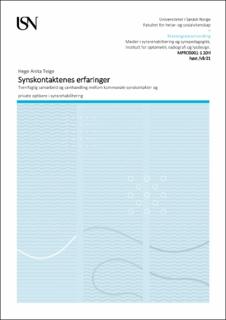| dc.contributor.advisor | Myklebust, Arnulf | |
| dc.contributor.advisor | Thorud, Hanne-Mari Sciøtz | |
| dc.contributor.author | Teige, Hege Anita | |
| dc.date.accessioned | 2023-05-02T16:41:26Z | |
| dc.date.available | 2023-05-02T16:41:26Z | |
| dc.date.issued | 2021 | |
| dc.identifier | no.usn:wiseflow:2513881:40858819 | |
| dc.identifier.uri | https://hdl.handle.net/11250/3065852 | |
| dc.description.abstract | Bakgrunn: Tverrfaglig samhandling og samarbeid i synsrehabilitering kan bidra til å lette hverdagen til mennesker med ervervet synsnedsettelse. Synskontakter er ofte kommunalt ansatte ergoterapeuter som har ansvar for synsrehabilitering og hjelpemiddelformidling. Denne yrkesgruppen har begrenset synsfaglig kunnskap, og det har i liten grad blitt undersøkt hvordan synskontaktene samhandler og samarbeider med lokale optikere for bedre å kunne bistå den synshemmede brukeren. Hensikten med denne studien var å innhente kommunale synskontakter sine subjektive erfaringer i samhandling og samarbeid med lokale optikere. Videre å undersøke om holdning og forhold til optikere var forskjellige blant synskontakter som allerede har en form for formalisert samarbeid og dem som ikke har det. Metode: Studien har benyttet en kvalitativ forskningsmetode med fenomenologisk hermeneutisk design. Elleve kommunale synskontakter ble delt inn i to grupper, hvorav den ene (gruppe 1) ikke hadde erfaring med formalisert samhandling og samarbeid med private optikere i synsrehabilitering og hjelpemiddelformidling, og den andre (gruppe 2) hadde slik erfaring fra det lokale samarbeidsprosjektet «Brukes ve og vel» i Vestfold (2015). Intervjuer med hver av synskontaktene har blitt transkribert, og hele materialet analysert med en induktiv tilnærming. Resultater: To hovedkategorier ble identifisert gjennom analysen: «Rollefordeling i synsrehabilitering i kommunene» og «Kvalitetssikring av det kommunale tjenestetilbudet». Synskontaktene i gruppe 1 reflekterte rundt sin rolle i synsrehabilitering og mener lokale optikere er brukerorienterte fagpersoner med synsfaglig kompetanse som har en viktig rolle som samarbeidspartnere. Dette samarbeidet kan imidlertid vanskelig kalles tverrfaglig. I gruppe 2 har kurs, dialog og felles møteplass i regi av NAV Hjelpemiddelsentral og formaliserte lokale retningslinjer resultert i sterkere relasjoner mellom profesjonene; et tettere og mer effektivt tverrfaglig samarbeid i synsrehabiliteringen. Konklusjon: Studien viser at kommunale synskontakter og private optikere bedre kan utfylle hverandre i synsrehabilitering når samarbeidet formaliseres. Mennesker som erfarer synsnedsettelse, kan få synsfaglig bistand lokalt hos sin optiker og formidlingsprosessen kan lettes ved at synsrapport fra optiker til synskontakt brukes som grunnlag for henvisning til NAV Hjelpemiddelsentral og i formidling av synshjelpemidler individuelt tilpasset brukers behov.
Nøkkelord: Samhandling, samarbeid, synsrehabilitering, synskontakter, optikere, erfaringer, forskningsintervju. | |
| dc.description.abstract | Background: Interdisciplinary collaboration in vision rehabilitation can help facilitate the everyday lives of people with acquired visual impairment. “The municipal vision coordinator” are often municipally employed occupational therapists who are responsible for vision rehabilitation and assistive technology. This occupational group has limited visual professional knowledge, and little has been done to investigate how the municipal vision coordinators interact and collaborate with local optometrist to better assist the visually impaired user. The purpose of this study was to obtain the municipal vision coordinators subjective experiences in collaboration with local optometrist. Further to investigate whether attitude and relationships with optometrist were different amongst the municipal vision coordinators who already have some sort of formalized collaboration and those who do not. Method: The study has used a qualitative research method with phenomenological hermeneutic design. Eleven municipal vision coordinators were divided into two groups, one of which (group 1) had no experience with formalized collaboration with private optometrist in vision rehabilitation and assistive technology, and the other (group 2) had such experience from the local collaboration project «Brukes ve og vel » in Vestfold (2015). Interviews with each of the municipal vision coordinators has been transcribed, and the entire material analyzed with an inductive approach. Results: Two main categories were identified through the analysis: «Role distribution in vision rehabilitation in the municipalities» and «Quality assurance of the municipal service offer». The municipal vision coordinators in group 1 reflected on their role in vision rehabilitation and believe that local optometrist have visual professional competence, with an important role as partner. However, this collaboration can hardly be called interdisciplinary. In group 2, courses, dialogue and a common meeting place under the auspices of the NAV Assistive Technology Center and formalized local guidelines have resulted in stronger relations between the professions, a closer and more effective interdisciplinary collaboration in vision rehabilitation. Conclusion: The study shows that municipal vision coordinator and private optometrist can better complement each other in vision rehabilitation when the collaboration is formalized. People who experience visual impairment can receive professional assistance locally from their optician and the dissemination process can be facilitated by using the report from optometrist to municipal vision coordinator as a basis for referral to NAV Assistive Technology Center and in disseminating visual aids individually adapted to the user's needs. Keywords: Collaboration, vision rehabilitation, municipal vision coordinator, optometrist, experiences, research interviews | |
| dc.language | nob | |
| dc.publisher | University of South-Eastern Norway | |
| dc.title | Synskontaktenes erfaringer | |
| dc.type | Master thesis | |
